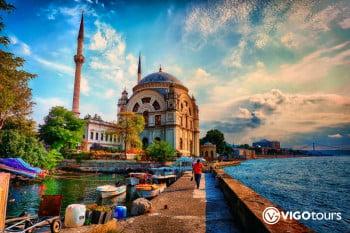Topkapi Palace (Topkapi Sarayi) is a historic palace that served as the primary residence of the Ottoman sultans for over 400 years, from the 15th to the 19th centuries. Nestled on the Seraglio Point, overlooking the Bosphorus Strait, this magnificent complex is a UNESCO World Heritage Site and a must-visit destination for anyone exploring Istanbul. With its stunning architecture, rich history, and breathtaking views, Topkapi Palace offers a fascinating glimpse into the opulent lifestyle of the Ottoman rulers.
1. Historical Overview
Overview: The origins and significance of Topkapi Palace
Constructed in the 15th century by Sultan Mehmed II after the conquest of Constantinople, Topkapi Palace was designed to serve as the administrative and residential center of the Ottoman Empire. It was not only a royal residence but also a symbol of the sultans' power and authority. Over the years, the palace underwent numerous expansions and renovations, resulting in a complex that reflects various architectural styles, from Byzantine to Islamic influences.
Topkapi Palace was home to the sultans and their families, as well as the imperial court and various officials. It housed the Imperial Harem, where the sultan's wives, concubines, and children lived. The palace also served as the seat of government and the location where important decisions were made, treaties signed, and ceremonies held.
2. Architectural Features
Overview: The beauty and layout of Topkapi Palace
Topkapi Palace is an expansive complex with multiple courtyards, gardens, and buildings, each serving a unique purpose. Some key architectural features include:
- The First Courtyard: This open area is accessible to the public and serves as an introduction to the palace. It features lush gardens, fountains, and the Gate of Salutation (Bab-i Selam), which marks the entrance to the inner courtyards.
- The Second Courtyard: This area houses several important structures, including the Imperial Council Chamber (Divan), where the Grand Vizier and council members met to discuss state affairs. The courtyard also features the Sultan's Mosque and the Palace Kitchens, which provided food for the royal court.
- The Third Courtyard: Reserved for the sultan and his family, this courtyard contains the Harem, a series of rooms and apartments where the sultan's wives and concubines lived. The Harem is known for its exquisite tile work and lavish interiors. Visitors can also explore the Treasury, which showcases an impressive collection of jewels, artifacts, and imperial treasures.
- The Fourth Courtyard: This area features the stunning Balcony of the Sultan, offering breathtaking views of the Bosphorus and the Golden Horn. The Library of Ahmed III and the Pavilion of the Sacred Relics, housing important religious artifacts, are also located here.
3. Cultural and Historical Significance
Overview: The impact of Topkapi Palace on the Ottoman Empire and beyond
Topkapi Palace played a crucial role in the development of the Ottoman Empire and its cultural heritage:
- Political Center: As the seat of power, Topkapi Palace was where sultans ruled, made critical decisions, and conducted diplomatic relations. It was the center of Ottoman governance for centuries, influencing the political landscape of the region.
- Cultural Hub: The palace was a melting pot of diverse cultures, reflecting the empire's vast territories. It was home to scholars, artists, and craftsmen, fostering a rich cultural environment that produced remarkable works of art, literature, and architecture.
- Symbol of Power: Topkapi Palace embodies the grandeur and opulence of the Ottoman Empire. Its architectural beauty, intricate tile work, and lavish interiors symbolize the wealth and power of the sultans.
4. Visiting Topkapi Palace
Overview: What to expect during your visit
A visit to Topkapi Palace is an immersive experience that transports you back in time:
- Entrance and Admission: Topkapi Palace requires an entrance fee, which includes access to the main areas of the palace. Visitors can purchase tickets at the entrance or online in advance to avoid long queues.
- Guided Tours: To fully appreciate the history and significance of Topkapi Palace, consider joining a guided tour. Knowledgeable guides provide insights into the palace's architecture, history, and the lives of the sultans.
5. Practical Tips for Visiting
Overview: Ensuring a smooth visit to Topkapi Palace
To enhance your experience at Topkapi Palace, keep these tips in mind:
- Best Time to Visit: The best time to visit is early in the morning or late in the afternoon, especially during weekdays. Avoid weekends and public holidays when the palace can be crowded.
- Dress Code: Although there is no strict dress code, visitors are advised to dress modestly, especially when visiting the Harem and mosques.
- Nearby Attractions: After exploring Topkapi Palace, consider visiting nearby attractions such as Hagia Sophia, the Blue Mosque, and the Basilica Cistern, all within walking distance.
Conclusion
Topkapi Palace is a mesmerizing journey into the heart of the Ottoman Empire, showcasing the splendor and sophistication of a bygone era. From its grand architecture to its rich history, the palace offers an unforgettable experience for visitors. As you wander through its courtyards and admire its exquisite details, you’ll gain a deeper understanding of the cultural heritage that shaped Istanbul into the vibrant city it is today. A visit to Topkapi Palace is not just an exploration of a historic site; it’s an opportunity to connect with the legacy of one of history's most influential empires.
Find it more: Things to do in istanbul

